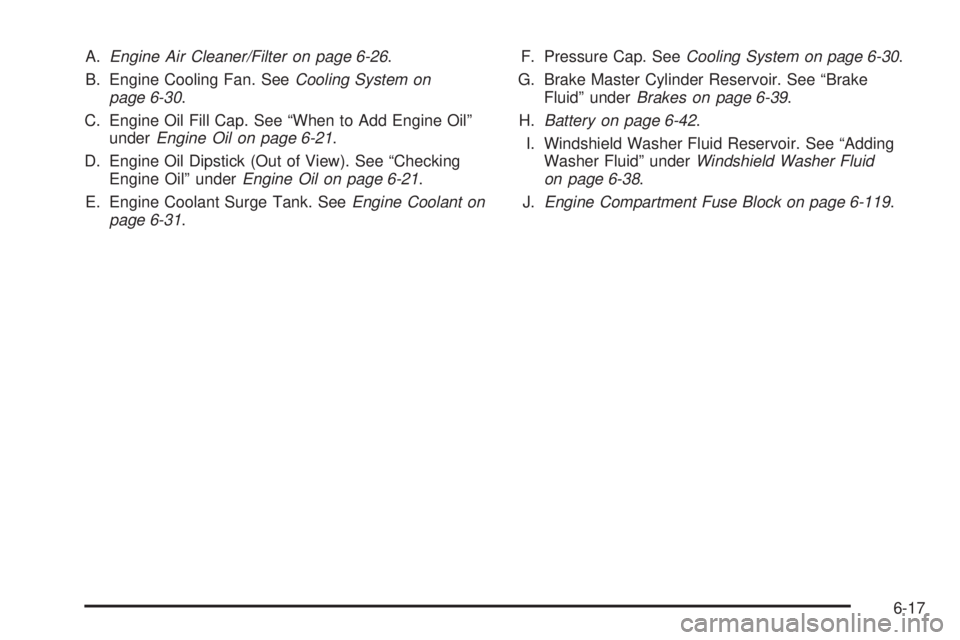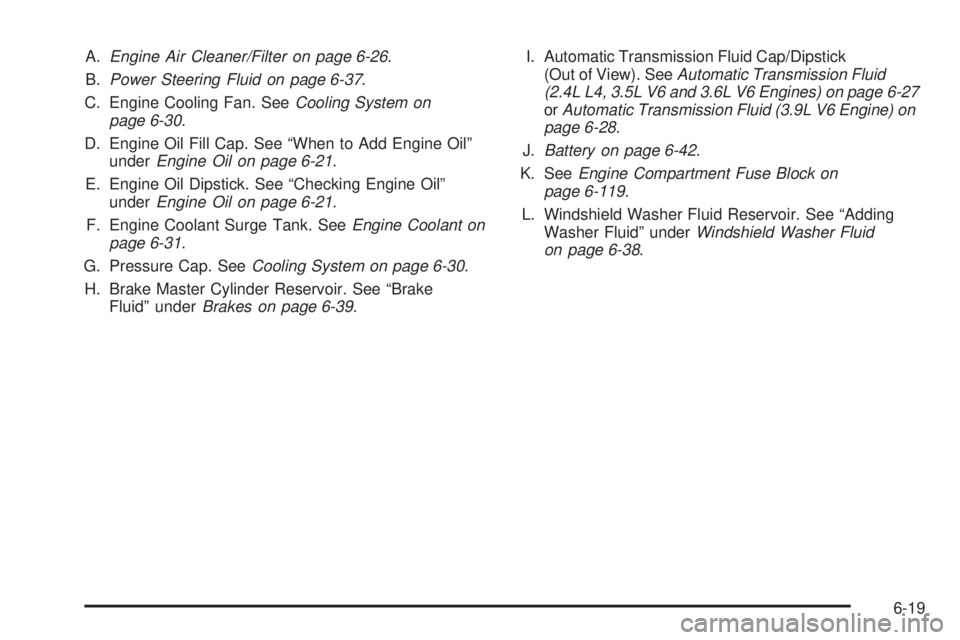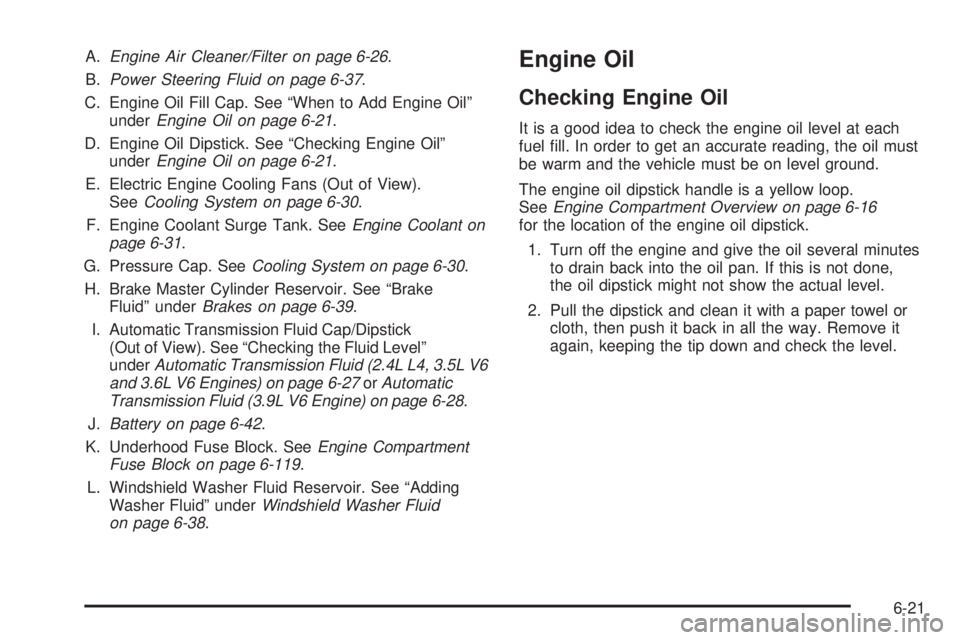check engine PONTIAC G6 2010 Owner's Manual
[x] Cancel search | Manufacturer: PONTIAC, Model Year: 2010, Model line: G6, Model: PONTIAC G6 2010Pages: 448, PDF Size: 2.5 MB
Page 279 of 448

Fuels in Foreign Countries
If you plan on driving in another country outside the
United States or Canada, the proper fuel might be hard
to find. Never use leaded gasoline or any other fuel
not recommended in the previous text on fuel. Costly
repairs caused by use of improper fuel would not
be covered by the vehicle warranty.
To check the fuel availability, ask an auto club, or
contact a major oil company that does business in
the country where you will be driving.
Filling the Tank
{WARNING:
Fuel vapor burns violently and a fuel fire can
cause bad injuries. To help avoid injuries to you
and others, read and follow all the instructions on
the fuel pump island. Turn off the engine when
refueling. Do not smoke near fuel or when
refueling the vehicle. Do not use cellular phones.
WARNING: (Continued)
WARNING: (Continued)
Keep sparks, flames, and smoking materials away
from fuel. Do not leave the fuel pump unattended
when refueling the vehicle. This is against the law
in some places. Do not re-enter the vehicle while
pumping fuel. Keep children away from the fuel
pump; never let children pump fuel.
The tethered fuel cap is located behind a hinged fuel
door on the passenger side of the vehicle.
6-11
Page 282 of 448

Checking Things Under
the Hood
{WARNING:
An electric fan under the hood can start up and
injure you even when the engine is not running.
Keep hands, clothing, and tools away from any
underhood electric fan.
{WARNING:
Things that burn can get on hot engine parts and
start a fire. These include liquids like fuel, oil,
coolant, brake fluid, windshield washer and other
fluids, and plastic or rubber. You or others could
be burned. Be careful not to drop or spill things
that will burn onto a hot engine.
6-14
Page 285 of 448

A.Engine Air Cleaner/Filter on page 6-26.
B. Engine Cooling Fan. SeeCooling System on
page 6-30.
C. Engine Oil Fill Cap. See “When to Add Engine Oil”
underEngine Oil on page 6-21.
D. Engine Oil Dipstick (Out of View). See “Checking
Engine Oil” underEngine Oil on page 6-21.
E. Engine Coolant Surge Tank. SeeEngine Coolant on
page 6-31.F. Pressure Cap. SeeCooling System on page 6-30.
G. Brake Master Cylinder Reservoir. See “Brake
Fluid” underBrakes on page 6-39.
H.Battery on page 6-42.
I. Windshield Washer Fluid Reservoir. See “Adding
Washer Fluid” underWindshield Washer Fluid
on page 6-38.
J.Engine Compartment Fuse Block on page 6-119.
6-17
Page 287 of 448

A.Engine Air Cleaner/Filter on page 6-26.
B.Power Steering Fluid on page 6-37.
C. Engine Cooling Fan. SeeCooling System on
page 6-30.
D. Engine Oil Fill Cap. See “When to Add Engine Oil”
underEngine Oil on page 6-21.
E. Engine Oil Dipstick. See “Checking Engine Oil”
underEngine Oil on page 6-21.
F. Engine Coolant Surge Tank. SeeEngine Coolant on
page 6-31.
G. Pressure Cap. SeeCooling System on page 6-30.
H. Brake Master Cylinder Reservoir. See “Brake
Fluid” underBrakes on page 6-39.I. Automatic Transmission Fluid Cap/Dipstick
(Out of View). SeeAutomatic Transmission Fluid
(2.4L L4, 3.5L V6 and 3.6L V6 Engines) on page 6-27
orAutomatic Transmission Fluid (3.9L V6 Engine) on
page 6-28.
J.Battery on page 6-42.
K. SeeEngine Compartment Fuse Block on
page 6-119.
L. Windshield Washer Fluid Reservoir. See “Adding
Washer Fluid” underWindshield Washer Fluid
on page 6-38.
6-19
Page 289 of 448

A.Engine Air Cleaner/Filter on page 6-26.
B.Power Steering Fluid on page 6-37.
C. Engine Oil Fill Cap. See “When to Add Engine Oil”
underEngine Oil on page 6-21.
D. Engine Oil Dipstick. See “Checking Engine Oil”
underEngine Oil on page 6-21.
E. Electric Engine Cooling Fans (Out of View).
SeeCooling System on page 6-30.
F. Engine Coolant Surge Tank. SeeEngine Coolant on
page 6-31.
G. Pressure Cap. SeeCooling System on page 6-30.
H. Brake Master Cylinder Reservoir. See “Brake
Fluid” underBrakes on page 6-39.
I. Automatic Transmission Fluid Cap/Dipstick
(Out of View). See “Checking the Fluid Level”
underAutomatic Transmission Fluid (2.4L L4, 3.5L V6
and 3.6L V6 Engines) on page 6-27orAutomatic
Transmission Fluid (3.9L V6 Engine) on page 6-28.
J.Battery on page 6-42.
K. Underhood Fuse Block. SeeEngine Compartment
Fuse Block on page 6-119.
L. Windshield Washer Fluid Reservoir. See “Adding
Washer Fluid” underWindshield Washer Fluid
on page 6-38.Engine Oil
Checking Engine Oil
It is a good idea to check the engine oil level at each
fuel fill. In order to get an accurate reading, the oil must
be warm and the vehicle must be on level ground.
The engine oil dipstick handle is a yellow loop.
SeeEngine Compartment Overview on page 6-16
for the location of the engine oil dipstick.
1. Turn off the engine and give the oil several minutes
to drain back into the oil pan. If this is not done,
the oil dipstick might not show the actual level.
2. Pull the dipstick and clean it with a paper towel or
cloth, then push it back in all the way. Remove it
again, keeping the tip down and check the level.
6-21
Page 292 of 448

Engine Oil Additives / Engine Oil
Flushes
Do not add anything to the oil. The recommended
oils with the starburst symbol that meet GM Standard
GM6094M are all that is needed for good performance
and engine protection.
Engine oil system flushes are not recommended and
could cause engine damage not covered by the vehicle
warranty.
Engine Oil Life System
When to Change Engine Oil
This vehicle has a computer system that indicates when
to change the engine oil and filter. This is based on
engine revolutions and engine temperature, and not on
mileage. Based on driving conditions, the mileage at
which an oil change is indicated can vary considerably.
For the oil life system to work properly, the system must
be reset every time the oil is changed.When the system has calculated that oil life has been
diminished, it indicates that an oil change is necessary.
A CHANGE OIL SOON message comes on. SeeDIC
Warnings and Messages on page 4-42. Change the oil
as soon as possible within the next 600 miles (1 000 km).
It is possible that, if driving under the best conditions, the
oil life system might not indicate that an oil change is
necessary for over a year. However, the engine oil and
filter must be changed at least once a year and at this
time the system must be reset. Your dealer/retailer has
trained service people who will perform this work using
genuine parts and reset the system. It is also important to
check the oil regularly and keep it at the proper level.
If the system is ever reset accidentally, the oil must be
changed at 3,000 miles (5 000 km) since the last oil
change. Remember to reset the oil life system whenever
the oil is changed.
6-24
Page 295 of 448

{WARNING:
Operating the engine with the air cleaner/filter off
can cause you or others to be burned. The air
cleaner not only cleans the air; it helps to stop
flames if the engine backfires. If it is not there and
the engine backfires, you could be burned. Do not
drive with it off, and be careful working on the
engine with the air cleaner/filter off.
Notice:If the air cleaner/�lter is off, a back�re
can cause a damaging engine �re. And, dirt can
easily get into the engine, which will damage it.
Always have the air cleaner/�lter in place when you
are driving.
Automatic Transmission Fluid
(2.4L L4, 3.5L V6 and
3.6L V6 Engines)
It is not necessary to check the transmission fluid level.
A transmission fluid leak is the only reason for fluid loss.
If a leak occurs, take your vehicle to the dealer/retailer
and have it repaired as soon as possible.
Change the fluid and filter at the intervals listed in
Scheduled Maintenance on page 7-3and be sure to
use the transmission fluid listed inRecommended Fluids
and Lubricants on page 7-10.
Notice:Use of the incorrect automatic transmission
�uid may damage the vehicle, and the damages
may not be covered by the vehicle’s warranty.
Always use the automatic transmission �uid listed
inRecommended Fluids and Lubricants on
page 7-10.
For the 2.4 L, 3.5 L and 3.6 L engines, the transmission
fluid will not reach the end of the dipstick unless the
transmission is at operating temperature. If the
transmission fluid level must be checked, take the
vehicle to the dealer/retailer.
6-27
Page 296 of 448

Automatic Transmission Fluid
(3.9L V6 Engine)
When to Check and Change Automatic
Transmission Fluid
A good time to check the automatic transmission fluid
level is when the engine oil is changed.
Change the fluid and filter at the intervals listed in
Scheduled Maintenance on page 7-3and be sure to
use the transmission fluid listed inRecommended
Fluids and Lubricants on page 7-10.
How to Check Automatic Transmission
Fluid
Because this operation can be a little difficult, you may
choose to have this done at the dealer/retailer service
department.
If you do it yourself, be sure to follow all the instructions
here or you could get a false reading on the dipstick.Notice:Too much or too little �uid can damage your
transmission. Too much can mean that some of the
�uid could come out and fall on hot engine parts or
exhaust system parts, starting a �re. Too little �uid
could cause the transmission to overheat. Be sure
to get an accurate reading if you check your
transmission �uid.
Wait at least 30 minutes before checking the
transmission fluid level if you have been driving:
•When outside temperatures are above 32°C (90°F).
•At high speed for quite a while.
•In heavy traffic — especially in hot weather.
•While pulling a trailer.
To get the right reading, the fluid should be at
normal operating temperature, which is 82°C to 93°C
(180°F to 200°F).
Get the vehicle warmed up by driving about
24 km (15 miles) when outside temperatures are
above 10°C (50°F). If it is colder than 10°C (50°F),
you may have to drive longer.
6-28
Page 297 of 448

Checking the Fluid Level
Prepare the vehicle as follows:
1. Park the vehicle on a level place. Keep the engine
running.
2. With the parking brake applied, place the shift lever
in P (Park).
3. With your foot on the brake pedal, move the
shift lever through each gear, pausing for about
three seconds in each one. Then, position the
shift lever in P (Park).
4. Let the engine run at idle for three to five minutes.
Then, without shutting off the engine, follow these
steps:
1. The transmission
fluid dipstick handle
has this symbol on it,
and is located near
the rear of the engine
compartment.
SeeEngine Compartment Overview on page 6-16
for more information on location.
2. Remove the dipstick and wipe it with a clean rag or
paper towel.3. Reinstall it back in all the way, wait three seconds,
and then pull it back out again.
4. Check both sides of the dipstick and read the
lower level. The fluid level must be within the
crosshatched area.
5. If the fluid level is in the acceptable range, reinstall
the dipstick back in all the way.
6-29
Page 298 of 448

How to Add Automatic Transmission
Fluid
Refer to the Maintenance Schedule to determine what
kind of transmission fluid to use. SeeRecommended
Fluids and Lubricants on page 7-10.
If the fluid level is low, add only enough of the proper
fluid to bring the level into the crosshatched area on
the dipstick.
1. Remove the dipstick.
2. Using a long-neck funnel, add enough fluid at the
dipstick hole to bring it to the proper level.
It does not take much fluid, generally less than a
half pint (0.24 L). Do not overfill.
Notice:Use of the incorrect automatic transmission
�uid may damage the vehicle, and the damages
may not be covered by the vehicle’s warranty.
Always use the automatic transmission �uid listed
inRecommended Fluids and Lubricants on
page 7-10.
3. After adding fluid, recheck the fluid level as
described under “How to Check Automatic
Transmission Fluid” earlier in this section.
4. When the correct fluid level is obtained, reinstall the
dipstick back in all the way.
Cooling System
The cooling system allows the engine to maintain the
correct working temperature.
A. Engine Cooling Fans
B. Engine Coolant Surge Tank
C. Pressure Cap3.6L V6 Engine shown, 2.4L L4, 3.5L,
3.9L Engines similar
6-30